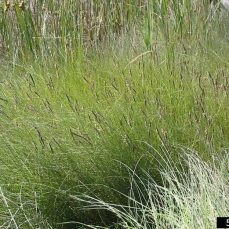
Photo credit: Marilee Lovit
Management Category
Squamish
Whistler
Vancouver
Vectors of Spread
Synonyms
Salt marsh cordgrass
ID Characteristics
Perennial grass in the Poaeceae family and Spartina species. Spartina are the only grass species which can survive in stressful low salt mash environments.
Flowers: Droopy deciduous spikes (0.7 – 1 cm) of reddish flowers arranged in an overlapping fashion.
Stems: Slender and pliant, growing in dense mats up to 1.2 m tall.
Leaves: Light green, inward-rolled, deciduous, and narrow. Leaf size varies greatly: from 1 – 4 mm wide and 10 – 50 cm long.
Roots: Long and wiry.
Seeds: Arise only on one side of flower spikes.
Similar Species

Photo credit: Nisa Karimi, Wisconsin Department of Natural Resources, Bugwood.org
Invasive
- Dense-flowered cordgrass (Spartina densiflora)
- English cordgrass (Spartina anglica)
- Smooth cordgrass (Spartina alterniflora)
Saltmeadow cordgrass can be extremely challenging to distinguish from other grass species. Accordingly, we recommend the use of a detailed key for positive identification (please refer to the references section for more links).

Photo credits: Rob Routledge, Sault College, Bugwood.org
Native
- Seashore saltgrass (Distichlis spicata) has rhizomes (fleshy roots) and is shorter (10 – 40 cm).
- Seaside plantain (Plantago maritima) is shorter (up to 25 cm tall).
- American dunegrass (Leymus mollis, L. arenarius) has thick rhizomes (fleshy roots) and its leaves are slightly hairy on top. Its flowers are also a greenish yellow tone, rather than a reddish one for Saltmeadow cordgrass.
- Seaside arrow-grass (Triglochin maritima) has small purple flowers that are clustered along the length of the flowering stem.
Habitat and Origin
Saltmeadow cordgrass is native to the Atlantic Coast of North America and the Gulf coast of the United States.
This salt-tolerant species prefers the upper salt marsh tidal zone, but can also establish in sand dunes and sand flats. It thrives in open and exposed sites and it can tolerate occasional inundations.
How it Spreads
Saltmeadow cordgrass primarily spreads by root fragments called rhizomes. It can also germinate by seed on low sand flats with suitable moisture. When released, seeds can float for up to 26 days and can remain viable until the following spring if they are kept wet and cool.
Saltmeadow cordgrass root fragments and seeds spread primarily by tidal currents, but can also be dispersed by birds, ballast water, dredging, aquaculture and intentional planting for erosion control.
Impacts
Ecological:
- Significantly decreases habitat and nursery grounds for birds and fish.
- Soil accretion alters hydrology of an area and disrupts tidal drainage patterns, which can increase flooding.
- Excludes native vegetation from the high marsh zone, which creates a monoculture.
Economic:
- Negatively impacts coastal-based industries, such as tourism.
- Soil accretion affects navigation and can cause flooding.
Prevent the Spread
Saltmeadow cordgrass is NOT currently found in the Sea to Sky Corridor, so the best approach to controlling its spread is by PREVENTION.
This is a high-priority invasive species for the Province of BC, and it is included in the Early Detection and Rapid Response (EDRR) program.
If you see Saltmeadow cordgrass, please report it.
Saltmeadow Cordgrass Distribution in BC
Saltmeadow Cordgrass Factsheet
Having trouble viewing the factsheet? Don’t worry, all the information is included on this page. You can also contact us with any questions.
Additional Resources
References
- B.C. Spartina Working Group. Spartina.
- Coastal Invasive Species Committee. Cordgrass, Salt meadow.
- Electronic Atlas of the Flora of British Columbia, Spartina patens
- Go Botany Native Plant Trust, Spartina
- Government of British Columbia. Saltmeadow cordgrass
- Government of British Columbia, Cordrasses (Spartina anglica, S. densiflora, S. patens) Frequently Asked Questions
- Government of Oregon. Saltmeadow cordgrass
- Invasive Plant Atlas. Saltmeadow cordgrass
- Oregon Department of Agriculture, Key to West Coast Spartina Species Based on Vegetative Characteristics
- Washington State Noxious Weed Control Board. Salt Meadow Cordgrass













